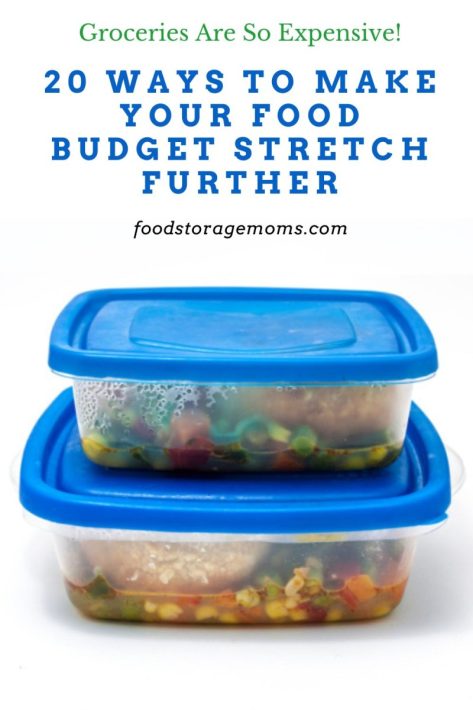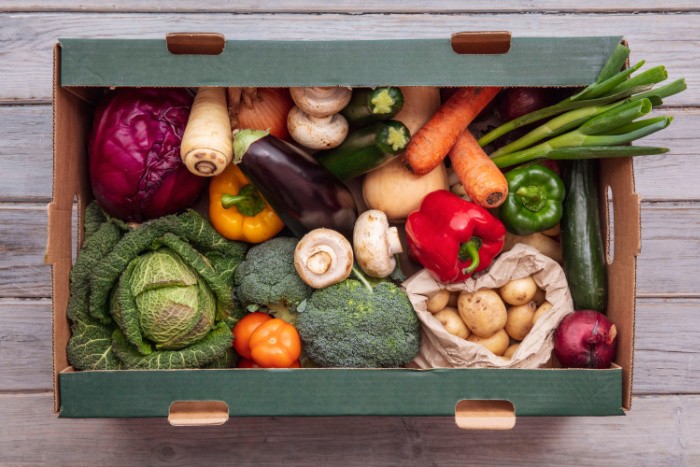20 Ways to Make Your Food Budget Stretch Further
In a world where grocery prices seem to constantly rise, finding ways to stretch your food budget is essential. Fortunately, numerous strategies and tips can help you make the most of every dollar spent on groceries. Let’s talk about 20 ways to make your food budget stretch further.
Each time I go to the store I’m amazed at the cost of things. I wonder how larger families, particularly those with growing teenagers, can afford to feed their crew. Hopefully, the things we’ve included in the post today can give you some new ideas as you try to provide healthy and tasty meals.

20 Ways to Make Your Food Budget Stretch Further
1. Meal Planning and Batch Cooking
One of the most effective ways to make your food last longer is through meal planning and batch cooking. By preparing larger quantities of meals and portioning them out for the week, you not only save time but also reduce the likelihood of impulse spending on takeout. 20 Laundry Tips to Make Your Life Easier
When you plan your next food shopping trip, take some time to prepare a weekly menu plan and then purchase only those items you need to prepare the meals outlined in your menu. It’s a given that you want to purchase things that your family enjoys and will actually eat. Most people steer clear of various items based on their texture, flavor, and allergy issues.
The menu plan helps you avoid impulse buying, and those impulse purchases often cost more too.
2. Embrace Leftovers
Leftovers often get a bad rap, but they can be a budget-conscious cook’s best friend. Get creative with repurposing leftovers into new and exciting dishes, preventing food waste and saving money in the process. Food Storage Tips for Your Groceries and Leftovers By many estimates, families in the United States waste between 30% – 40% of the foods they purchase. That’s hard to believe!
As you plan your meals, try to adjust the volume of items prepared to match who will be eating the meals. It can become a guessing game, but over time you learn what foods are liked most and will be eaten first. You can place any leftover items in containers that fit in your refrigerator or freezer for later.
You can also plan to use those foods in an entree that allows for a combination of items, like stir-fries.
Some of my favorite leftover containers are Rubbermaid Leak-Prook Containers
3. Buy in Bulk
Purchasing non-perishable items in bulk can significantly lower the cost per unit, often referred to as unit pricing. Most stores now include the price per ounce on their shelf pricing tags. Look for deals on pantry staples like rice, pasta, and beans, and store them in airtight containers to maintain freshness. Prepping Items You Can Buy From The Dollar Tree
Convenience stores are given that name for a reason, they have certain items that we look for as a convenience, not based on the price. You’ll find they have higher prices across their inventory unless they are having a season-ending sale or liquidation.
4. Shop Seasonal Produce
Fruits and vegetables in season are not only fresher but also more affordable. Plan your meals around seasonal produce to take advantage of lower prices and better quality. How to Maximize Your Garden’s Production
Hopefully, you live in an area that has farmer’s markets available. It’s fun to buy things directly from the group who planted, raised, and harvested the produce. You can ask a bunch of questions about varieties, nutrition, and cooking ideas. You more than likely will also pay less.
5. Grow Your Herbs
Herbs can add flavor to your dishes without breaking the bank. Consider growing your herbs at home, whether it’s on a windowsill or in a small garden. This not only saves money but also adds a touch of freshness to your cooking. Top Herbs That Work Great for Healing
It can be a wonderful family exercise to grow your own garden and raise those fruits and vegetables your family truly enjoys. When our girls were growing up we lived on a 1/2 acre lot in Cache Valley, Utah. We had a huge garden and the kids learned what it took to raise the foods we loved eating. We had one large section of the garden where we grew strawberries, and every night during the summer we had berries with our dinner. I love those memories!
6. Use Coupons and Discounts
Keep an eye out for coupons and discounts at your local grocery store. Many supermarkets offer loyalty programs, and there are various coupon apps that can help you save money on your favorite products. 10 Simple Ideas on Beginning Prepping
7. Shop Generic Brands
Generic or store brand products are often just as good as the name brands but come at a lower price. Give them a try and see if you can make the switch without sacrificing quality. How to Save Money on Canned Goods
8. Embrace Frozen and Canned Foods
Frozen and canned foods can be just as nutritious as fresh ones and often have a longer shelf life and lower prices. Stock up on frozen vegetables, fruits, and canned goods when they are on sale to stretch your budget. How To Dehydrate Frozen Vegetables and Make Vegetable Powder
9. Create Versatile Staple Dishes
Build your meal plans around versatile staple dishes that can be repurposed in various ways. For example, a simple roasted whole chicken can be used for sandwiches, salads, and wraps throughout the week. 50 Quick And Easy To Make Side Dishes
10. Reduce Meat Consumption
Meat can be one of the more expensive items on your grocery list. Consider incorporating more plant-based protein sources into your diet, such as beans, lentils, and tofu, to cut down on costs. 10 Budget-Friendly Ways to Transform Eggs into Delicious Meals
If you still feel the need for meat with your meals, consider a different cut of meat to fill that need. Beef comes in many varieties, but some cuts are much more cost-effective than others.
The same applies to chicken and fish. Consider tilapia and tuna rather than salmon when it comes to fish choices. Chicken breasts are usually a reasonably priced approach to cuts of chicken, but you can also buy whole chickens at a good price if you can deal with the bones. Pork is also a good choice for reasonably priced meat.
11. Shop at Discount Stores
Explore discount stores or warehouse clubs for budget-friendly options. You may find bulk items or discounted products that can help you make your food budget go further. How To Stock Your Home Pharmacy
12. Make Homemade Snacks
Pre-packaged snacks can be costly. Instead, make your own snacks at home, such as trail mix, granola bars, peanut butter and jam, or popcorn. Not only is this more economical, but you also have control over the ingredients. Best Snacks to Take With You
13. Preserve and Ferment
Preserving and fermenting foods are excellent ways to extend their shelf life. Experiment with pickling vegetables, making jams, or fermenting your sauerkraut to add flavor and longevity to your pantry. The Best Foods You Need In Your Pantry
For years we would go to fruit stands near our home and buy bushels of peaches, pears, and apricots that we’d bring home and can. Our girls grew up with canned fruit with their breakfast cereal or lunch sandwiches. The good thing is we could grab a bottle of these canned fruits off the basement storage shelf all year long.
14. Optimize Portion Sizes
Be mindful of portion sizes to avoid overeating and wasting food. Invest in reusable containers to store leftovers, making it easy to portion out meals for the next day. 100 Items That Will Disappear After An Emergency
15. Join a Community Garden
If you have access to a community garden, consider joining, particularly if you have limited growing space on your property. This provides an opportunity to grow your fresh produce at minimal cost and fosters a sense of community. How to Make a Community in Your Neighborhood
Suggest the community garden group grow a wide variety of vegetables, especially root vegetables like potatoes, sweet potatoes, beets, and onions.
16. Shop Online for Deals
Take advantage of online platforms to compare prices and find the best deals. Many online grocery stores offer discounts, and some even provide free shipping for bulk purchases. 10 Survival Items to Hunt For at Flea Markets
17. Cook from Scratch
Cooking from scratch allows you to control the ingredients and avoid the added costs of pre-packaged convenience foods. Invest time in learning simple recipes that can become staples in your kitchen. Cooking From Scratch Is It A Thing Of The Past?
18. Plan for Leftover Ingredients
When planning meals, consider how to use up all ingredients to minimize waste. For example, if a recipe calls for half a can of tomatoes, plan another dish that utilizes the remaining tomatoes. 20 Ways To Enjoy Turkey Leftovers
19. Participate in Community Swaps
Explore local community groups or online platforms where people swap excess produce or pantry items. This is a great way to diversify your food options without spending extra money. Creative Ways to Reuse Glassware for Prepping Purposes
20. DIY Convenience Foods
Rather than buying pre-packaged convenience foods, make your own. Prepare your salad dressings, spice blends, and sauces at home to save money and reduce the number of items you need to purchase. Easy To Make Bug Out Lanyard
More Tips
- 10 Meals to Make When You’re Low on Food
- 10 Reasons to Visit Your Local Food Pantry for Help
- How To Stock A Pantry
Final Word
Stretching your food budget doesn’t have to mean sacrificing taste or nutrition. With a bit of planning and creativity, you’ll find that making your food budget stretch further is both achievable and rewarding. If you have some other great ideas when it comes to saving money on food, please share them in the comments so I can pass them on to my readers. May God Bless this World, Linda
Copyright Images: Plastic Containers AdobeStock_74755423 By Denudmurt, Fresh Organic Fruit and Vegetables AdobeStock_333459750 By Ink drop























As someone who is not fond of leftovers, I do find the need sometimes to cook, even for one, a necessity. Most of those times, it is because so many things come in large containers from the store and my freezer is pretty small! So, when I do cook in larger batches than I need for one or two meals, I have had to come up with unique storage methods. I no longer have a dehydrator (it died) so I cannot dehydrate things like pasta sauce easily. But I do make freezer meal kits: for example, when I want something like spaghetti and meat balls, I cook enough spaghetti for several meals then freeze the spaghetti noodles, meat balls and sauce in serving sizes but not mixed because the noodles tend to get soggy in my opinion. I just put the sauce in a small reusable container that fits in the larger container. I do the same for pizza since I don’t eat a lot of pizza. I make very small pizza crusts (bake them at 450F for 5-7 minutes then let them cool) and freeze them with the sauce in a separate reusable container, toppings also separately and freeze the “kit”. I label the “kits” with reheating/cooking directions as well.
There are some things that I do enjoy eating several days in a row!! Soup/stew, bean dishes to name a couple.
HI Leanne, I love freezing leftovers in serving size containers. I like your idea of separating the different ingredients! Makiing small pizzas is what I need to do! I love that idea of freezing the baked crusts!! Love it! Linda
I love this post, there is to much waste. I am actually doing the leftover thing
tonight. My brother bought fried Chicken from Popeyes and I have a leftover
chicken breast so I am going to make Chicken salad for supper and beyond. I also
have taken out of my freezer a container with a half of a batch of hash in it. I will
have that for breakfast.
My sister called me from a grocery store this morning and they were just putting
out marked down Veggies. She got me a nice head of cauliflower for 9 cents. If I eat
just one meal it was worth the cost but I will eat more than that.
Keep up the awesome job on these posts Linda, your great
HI June, thank you for your kind words, my sweet friend. Oh, how I love Popeyes Chicken, they opened one in Southern Utah before we moved and we stopped to get some before we moved up north. It is so good!!!I bet chicken salad made with it would be so good!! I love to cook cauliflower and make a cheese sauce, we love it! It’s mac and cheese but with steamed cauliflower! I love hearing about good buy! 9 cents, woohoo! Linda
When our 4 kids were still living at home, ever Thursday was “Plan-over” day. The left overs were arranged on the kitchen island along with the making of salad, bread and butter along with cheese and crackers. Every thing was first come first served….. All the storage dishes went in the dishwasher, the refrigerator got wiped out, nothing went to waste, and Friday was grocery shopping day and garbage day. I would start making Christmas cookies and coffee cakes because they freeze so well, in September. I would label them chicken livers, so the kids would leave them alone.
Now since we still cook in volume, wether it is spaghetti sauce, pot roast, broccoli cheese chicken, or chili, half goes in the freezer. A full freezer could mean just thawing and reheating for weeks.
Hi Chris, the chicken livers, best comment ever!!! Now I have the giggles, I love that one! I like you plan-over, spread the leftovers out and let them choose, first come first serve. We do something similar here, I love a cleaned out refrigerator! Eat or freeze it is my motto as well when we make large batches of our favorites. Now I want to mke a coffee cake, today!! Linda
To stretch your ground meat – add dry oatmeal. I do this when I make meatloaf and hamburgers.
Hi Barb, oh that’s a good one. I forgot about that one. I’m going to add that to the post!! Thank you!! Linda